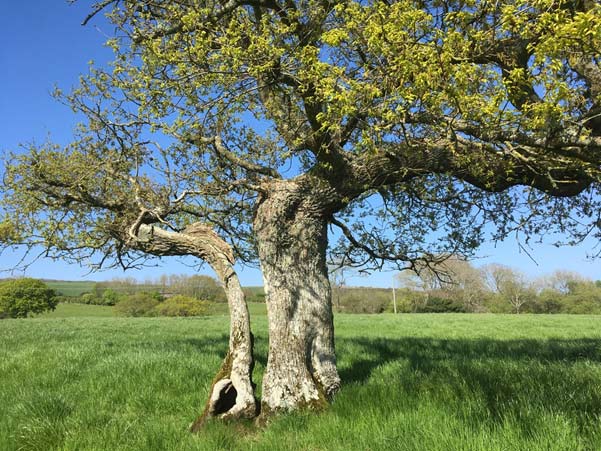I’m staring at a lovely
ripening mango – and can smell it too –
and musing on the colours of the skin. It
displays a little part of the rainbow as
the reds shift through orange and yellow
to green. In places it seems all those
colours are present at once, recalling a
Pointillist work of art with spots of
different hue on the skin playing tricks
on my eyes whilst my brain puts them
together to create the glowing image of
the fruit in my mind – which in turn
triggers the saliva glands in my mouth!!
The orange-yellow flesh inside glows with
sweet sunshine as if the warmth of the
tropics has been concentrated, packed into
a living parcel and flown across the world
to bless my senses with its delectable
sight, smell, and taste. How would you
describe the taste of a mango? Edible
sunshine? In a sense it actually is just
that.
The energy of the sun’s rays has been
captured by the mango leaves; the
chlorophyll – that amazing green catalyst
molecule – has married water and carbon
dioxide and bonded them with
sunlight-power to create sugar (sent to
the developing fruit to make mango juice)
and at the same time producing that other
life-giving molecule: oxygen. It’s
schoolgirl biochemistry but I still find
it an absolutely mind-blowing process,
brimming with the wisdom of God in action.
For me green is so very much the colour of
the life-giving Spirit of God – and yet in
a complimentary way to red, which I
explored in my previous Part 2 article.
The greening of the
Spirit
And so green and red, complimentary
colours in the paint box, both speak of
life in different ways. How fitting
that in different traditions of the church
these colours are both used liturgically
for the feast of Pentecost. See what we
can learn from each other!
Red – the colour of tongues of fire,
sacrifice and martyrdom – drapes our
Anglican church communion table on
Pentecost Sunday. But when I lived
in Russia we visited a Cathedral on the
eve of Orthodox Pentecost to find the
whole place decked in green, and living
green at that, with fresh birch branches
about all the doors and windows, and mown
grass strewn all over the floor – it
smelled like a newly cut lawn.
In the Bible the greening of the desert is
one of the most powerful images of the
life of God returning to a dried-up land
and a parched people. Isaiah 35.1
‘Let the wilderness and desert be glad.
Let the arid rift valley rejoice and bloom
like a lily.’
Have you ever seen one of those time lapse
films of what happens when the rains come
to arid places? Within a few days dormant
seeds come to life and rapidly shoot,
spread and bloom while the water is
available in order to set seed for the
next generation of plants.
Greening Desert 2017 –
Creative Worship Workshop at
Twyford School, Acton
It’s been recently confirmed that our
family will be moving with my husband’s
job to live in Oman so I’m hoping to see
something of that spectacle first hand. At
least the experience will make me utterly
more appreciative of “England’s green and
pleasant land” (where everyone complains
about the weather) even knowing that the
Irish have a thousand more shades of green
than we do – that come with even more wet
days. I will also miss the northern
passing of seasons – another of God’s
blessings – where each winter is just long
enough to really make me appreciate the
fresh green growth of Spring;
Apologies to antipodians who celebrate
Easter in the Autumn, and those of you in
the tropics who never get a winter, but I
do pray that as the days lengthen and the
sun’s heat gathers strength the firey
sunrise will remind you of the risen
Jesus, his golden light will power you up,
and that green shoots of renewal will
sprout as you put your roots into Him.
The Lord is my sun and my shield. (Psalm
84.11)
Be like ‘a tree planted by flowing
streams;
it yields its fruit at the proper time,
and its leaves never fall
off.
Psalm 1. 3

Cleft
oak tree still sprouting green in
old age. Near Church Knowle,
Dorset, UK.
Luke 11.11-13
What father among you, if your son asks
for a fish, will give him a snake instead
of a fish? Or if he asks for an egg, will
give him a scorpion? If you then, although
you are evil, know how to give good gifts
to your children, how much more will the
heavenly Father give the Holy Spirit to
those who ask him!”
Ask for an egg!!
Enjoy looking forward to a colourful
Easter and a powerful Pentecost.
Easter egg collage
card
Happy Easter!
from Ros Yates